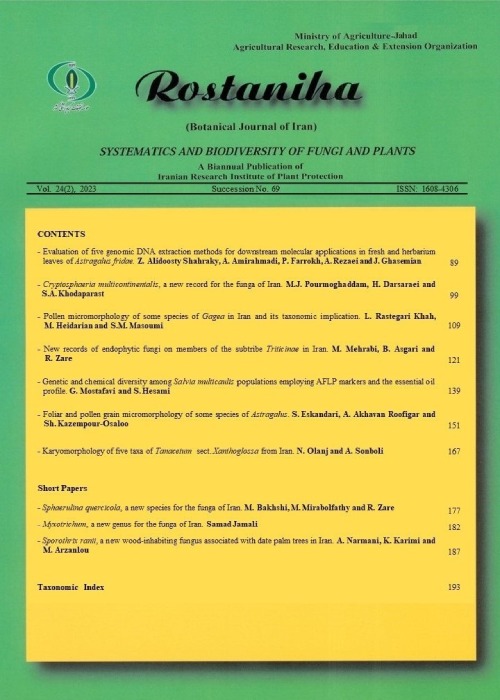Deightoniella arundinacea, new to mycobiota of Iran
Author(s):
Abstract:
During the visits of common reed [Phragmites australis (Cav.) Trin. ex Steud] in different locations of West Azerbaijan province during 201516, symptoms of fungal infections was frequently observed. Among the isolated and studied fungi, Deightoniella arundinacea (Corda) S. Hughes was commonly observed. Based on available literatures, this species was found new to mycobiota of Iran and is described below: The fungus causes dark grey to black lesions with yellow to light brown halos on both leaf surfaces (Fig. 1a).Conidiophores macronematous, mononematous, straight or flexuous, unbranched, light brown, smooth, 4395 × 49.5 μm, basal cell swollen, 1013 μm wide, erupt on both leaf surface. Conidiogenous cells are terminal, cylindrical, with thick side walls and a thin apical wall, integrated, percurrent, monoblastic (Figs 1bd). After detaching the first formed conidium, the thin apical wall of the conidiogenous cell apparently collapse, the growth of conidiophore is resumed from inner and mostly from the base and the new section of conidiophore pushes through the apex of old one (Fig. 1e). This process is repeated many times (Figs 1fg). Conidia solitary, obpyriform, acrogenous, light brown to golden brown, 12 septate, with a distinct hilum, 1952 × 1018 μm (Figs 1hj). Specimens examined: isolate Pa-12, Iran, West Azerbaijan province, Nazloo, Jun. 2015, Y. Ghosta; isolate Pa-25, Urmia Lake, Jul. 2015, Y. Ghosta; isolate Pa-49, Naqhadeh, Jun. 2016, M. Abrinbana; isolate Pa-124, Mahabad, Aug. 2016, M. Abrinbana (All from Phragmites australis leaves). Based on Index Fungorum (Aug. 2016, www.indexfungorum.org), 20 species are listed under Deightoniella. Among them, three species viz. D. arundinacea, D. constantinescui and D. roumegueri have been reported from Phragmites australis, although D. arundinacea has widespread distribution (Barbosa et al. 2007, Bahçecioglu & Kabaktepe 2009, Hughes 1952, Melnik & Shabunin 2011). These species are differentiated on the basis of conidium characteristics (size, shape and septation).
Language:
Persian
Published:
Botanical Journal of Iran, Volume:17 Issue: 1, 2016
Page:
92
magiran.com/p1586429
دانلود و مطالعه متن این مقاله با یکی از روشهای زیر امکان پذیر است:
اشتراک شخصی
با عضویت و پرداخت آنلاین حق اشتراک یکساله به مبلغ 1,390,000ريال میتوانید 70 عنوان مطلب دانلود کنید!
اشتراک سازمانی
به کتابخانه دانشگاه یا محل کار خود پیشنهاد کنید تا اشتراک سازمانی این پایگاه را برای دسترسی نامحدود همه کاربران به متن مطالب تهیه نمایند!
توجه!
- حق عضویت دریافتی صرف حمایت از نشریات عضو و نگهداری، تکمیل و توسعه مگیران میشود.
- پرداخت حق اشتراک و دانلود مقالات اجازه بازنشر آن در سایر رسانههای چاپی و دیجیتال را به کاربر نمیدهد.
In order to view content subscription is required
Personal subscription
Subscribe magiran.com for 70 € euros via PayPal and download 70 articles during a year.
Organization subscription
Please contact us to subscribe your university or library for unlimited access!


